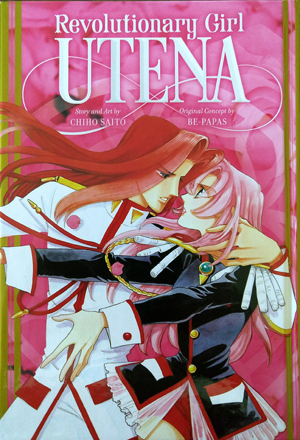
Mangaka: Chiho Saito, BE-PAPAS
Copyright: 1997/2017(Japan) 2017(English Translation)
Genre: Shoujo, Action, Fantasy, Shoujo Ai
Setting the Scene: skip this if you just want the review!
*I just spent hours on this review and nearly had it complete: and it was all lost when I hit a button to that accidentally took me “back” to the page I was previously viewing. I absolutely hate this short cut (I need to disable it.)
But the show must go on! I hope I’m able to recapture the essence of my first, lost review, in spite of being vastly disheartened! Sob for me! Weep and gnash your teeth! Oh, woe what a loss!
At least I’ve had some practice, eh? Let’s get to it!*
I was first introduced to Revolutionary Girl Utena quite a few years ago. It was long before I’d ever heard of Steven Universe. Actually, it may have been before Steven Universe even was a thing. Why am I talking about Steven Universe? This is an Utena review!
Well, because this series, at least the anime, was very inspirational to Steven Universe‘s creator, Rebecca Sugar.
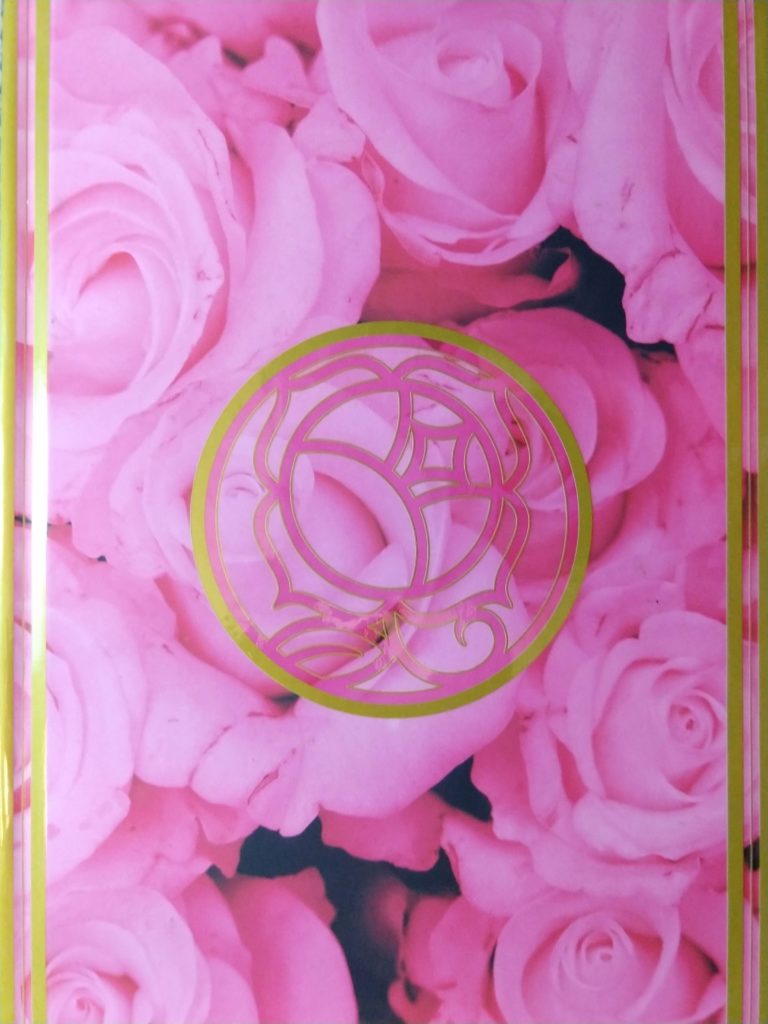
The Rose Seal motif of Utena is also important in Steven Universe. 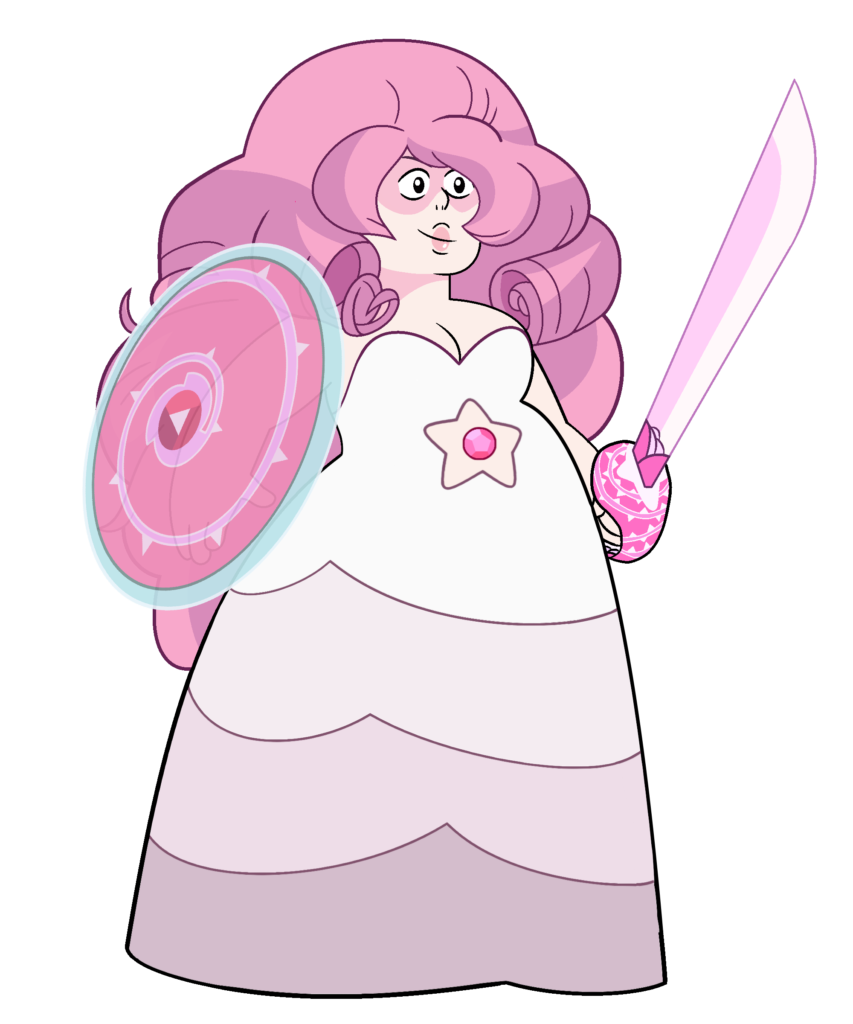
I don’t think it’s a coincidence that Rose Quartz had a shield mirroring that of the Rose Seal in Utena.
Image courtesy of Steven Universe Fandom Wiki
Okay, the above images seem like circumstantial evidence, but Sugar has actually created fan works of Revolutionary Girl Utena. The following can be found on her Twitter and Tumblr accounts.
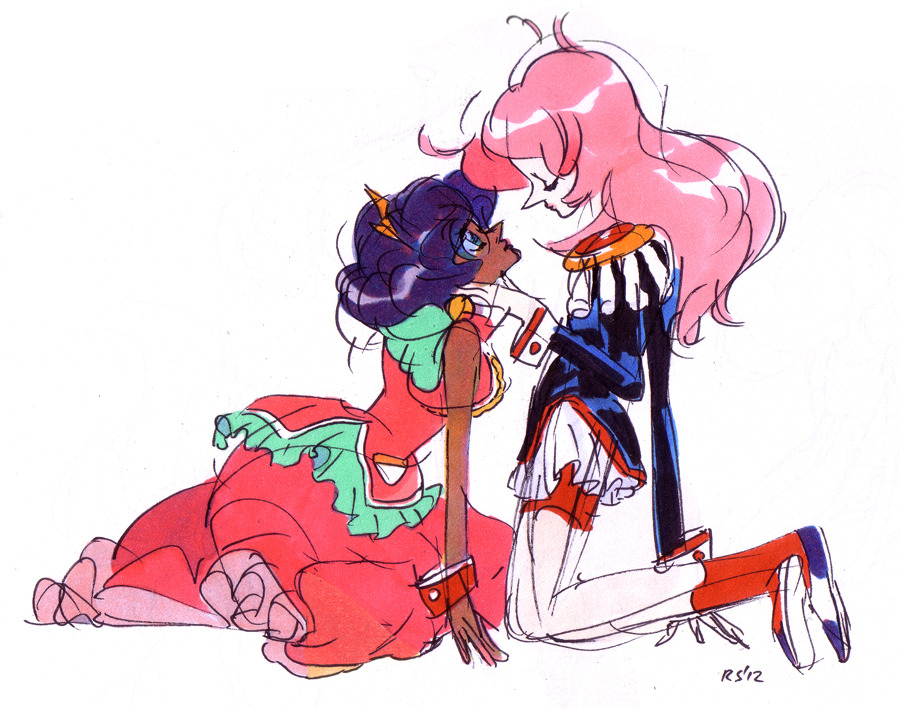
In addition to fan work, there are many themes in Steven Universe complimenting, and even expanding upon, those found in the story of Utena Tenjou and Anthy Himemiya. The ties of love, loyalty, honor, forgiveness, trust, and perseverance. The question of identity, gender roles, and gender stereotypes. Long before the ground breaking series of Steven Universe, Revolutionary Girl Utena shined a rose-tinted light upon gender stereotypes, breaking free of traditional roles and heralding forth a new type of heroine: one that is not bound by her gender, but rather one exemplifing the strengths, and weakness, of humanity (one could write a whole essay on this alone!)
Having first seen the anime, and then experiencing the manga, it’s easy to see what Rebecca Sugar liked about this series. And while it took me a second look at Utena, I think my experience with both stories have enriched each other. If you like non-traditional manga, regardless of whether you’re male, female, both, or non-binary, there’s much to be gained from reading this series.
*Before I get into the actual review, I want to impart the following upon readers.*
I am reviewing this series through Western eyes. I cannot speak on behalf of the Japanese audience. I cannot, and will not say, the views that I take are accepted within the Japanese culture (on the contrary, there are many struggles faced by the LGBT community abroad, to say nothing of the U.S.) To coin a phrase by Bob Dylan: “I can only think of terms of me.”
I am coming at this as (formerly) a rural Midwesterner, straddling the divide between “Generation X” and “Millennial.” And I guess I’m also coming from the view point of one who, although technically pan-sexual, does not really identify as part of the LGBT community.
What I mean to say is, although I feel attraction for whomever I feel attraction to, I’ve fortunately never felt the brunt of stereotypes and discrimination, at least not due to my sexual preferences. There was plenty more things to pick at! Oh trust me, I had my own trial by fire: it just didn’t have to do with gender or sexuality.
At the same time, I both empathize and sympathize with the LGBT rights moevement, and have found much inspiration, and well, identification with stories such as Utena. For me, I realize that any interpretation is going to be informed by my culture and upbringing. And here is no exception.
What I love about Utena is that like myself, she embodies both the feminine and masculine. She feels attractions for both, but is not defined by that attraction (and to be clear, I do identify as female.) And her love of both Touga and Himemiya is treated as both natural, and normal. No one, aside from perhaps those running the schools, really takes qualms with having homosexual crushes.
I understand this is a concept from shouji ai, and that at times girls are depicted as crushing on other girls, however, I want to make it clear that I do not know how prominent or accepted this is in the actual Japanese culture. I just like how, coming at this manga from my scope, sexuality, love, and gender, are handled very naturally and without a big “to-do.”
In other words, taking the manga outside of cultural context, one of its messages is “love is love.”
And that’s something I can jive with. Be excellent to each other! Enjoy the review.
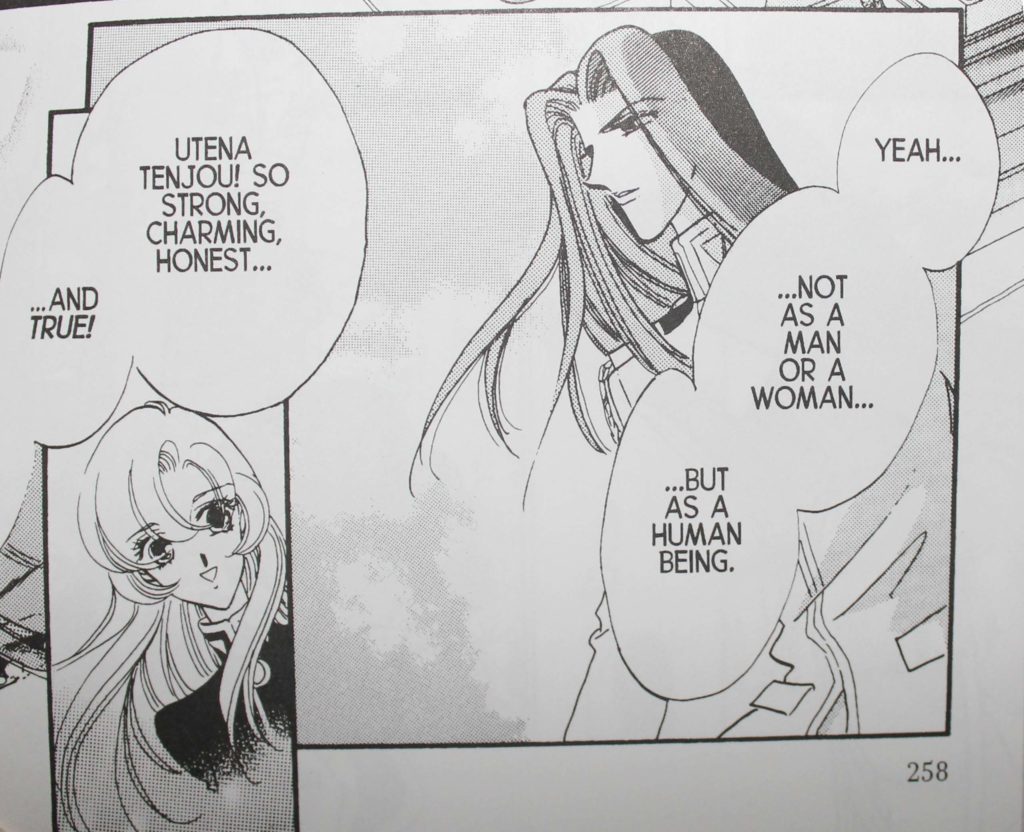
Summary: Potential spoilers
Utena Tenjou is a teen being raised by her aunt following the untimely death of her parents. Following their passing, a young, grieving Utena nearly drowns when she slips and falls toward a rushing canal. She is saved by a rose-scented, mysterious prince, who imparts upon her the wisdom of retaining her noble heart in hopes of perhaps meeting her in the future. He gifts her a ring with a rose seal upon it as a token of that future encounter, then disappears from her life.
Utena becomes transfixed on her savior, falling deeply in love with him, while also desiring to embody all that he represents to her. This obsession becomes an ingrained part of her identity, and much to her school’s chagrin, even extends into her wardrobe, as Utena exchanges the traditional girls’ attire for a tailor made, pink boys’ uniform.
When her aunt accepts a huge commission abroad, Utena nearly postpones her search for the mystery man, however, with the help of her friend, the two discover a secret found in the rose-sealed postcards Utena received annually, assumed to be from her prince. She transfers to the prestigious Ohtori Private Academy with high hopes of getting closer to the man who saved her life.
But something is rotten in the state of Ohtori!
While trying to defend a fellow classmate, Anthy Himemiya, Utena gets drawn into a strange dueling ritual held by the Student Counsel members, and orchestrated by World’s End, the mysterious organization heading Ohtori Academy.
As Utena is swept into the enigmatic world of Prince Dios, and the tournaments vying for the Rose Bride Anthy, Utena desperately tries to impart self-worth and value to her introverted friend. And just when she believes she’s become the prince she longed to be and freed her friend from the supernatural ritual of the Rose Bride, a shocking twist causes Utena to question herself and her identity, her friends, and even her prince and savior.
Throughout the story, Utena aspires to always be a good friend, a protector of the meek, an inspiration to her classmates, and a prince of noble heart. A self-less sacrifice at last leads Utena to freeing Anthy, and herself, from the vicious cycle spurred on by World’s End and her very own Prince Dio.
Pros and Cons: No Spoilers except when specified
Let’s start with the good.
I am tempted to write so much about this story. There’s so many themes and underlying concepts packed into these two volumes. There’s the Hindu inspired look of Anthy, Dios, and Akio, as well as the duality presented by many Hindu gods and their encompassing several genders and personas. There’s the deifying of one’s heroes, and even issues of domestic abuse and, especially in “The Adolescence of Utena,” sexual abuse. This series is jamb packed, and I can’t tackle it all, nor am I qualified to tackle it all.
With that said, I intend to just touch upon some of the broadest themes and things that stood out to, and touched me, personally.
I’ll be brief and let the art speak for itself. Well, I mean, I’ll have captions, but aside from those, enough said!
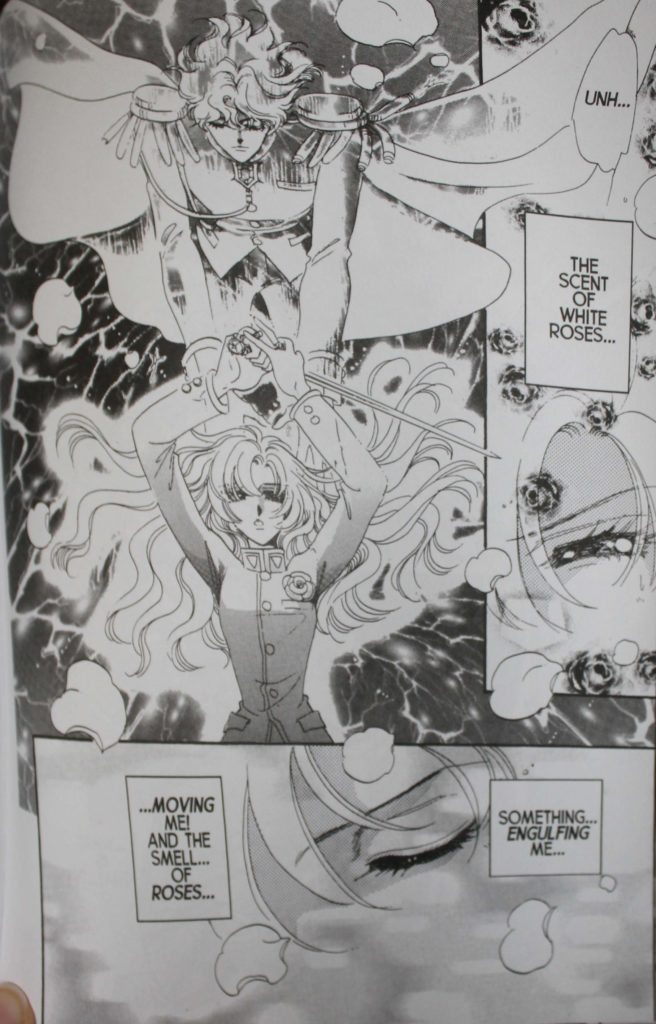
Imagery is wonderful! Utena is both one, and separate from her prince.
Vol. 1, pg 156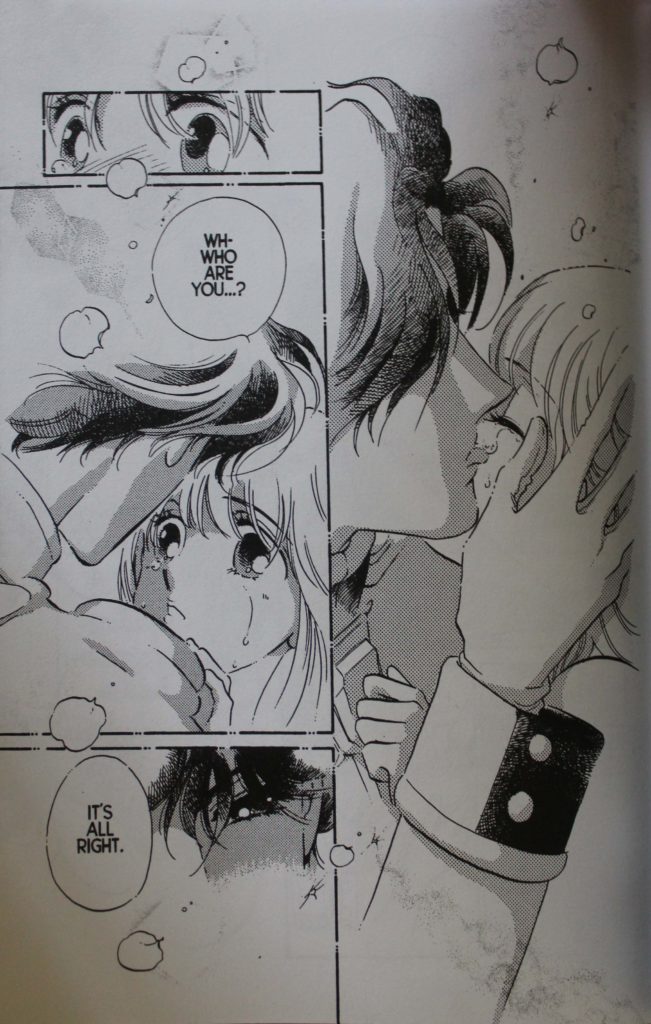
Although odd at times, Saito often mirrors themes and imagery from previous scenes to strengthen characterization.
Vol. 1 pg 43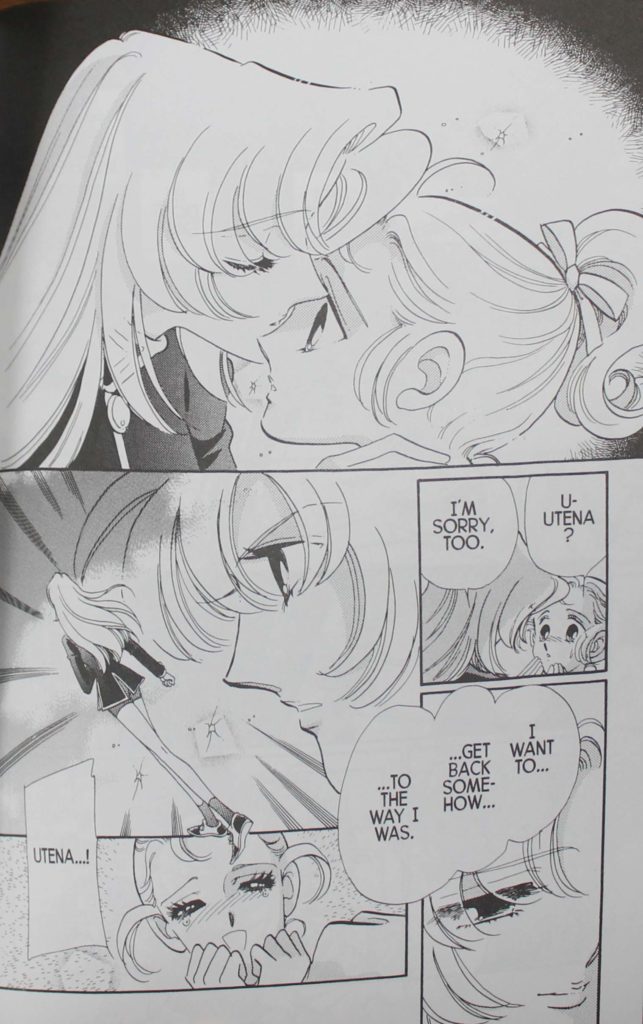
An example of mirroring, although there’s a better example in Volume Two, but it spoils too much to show.
Vol. 1, pg 458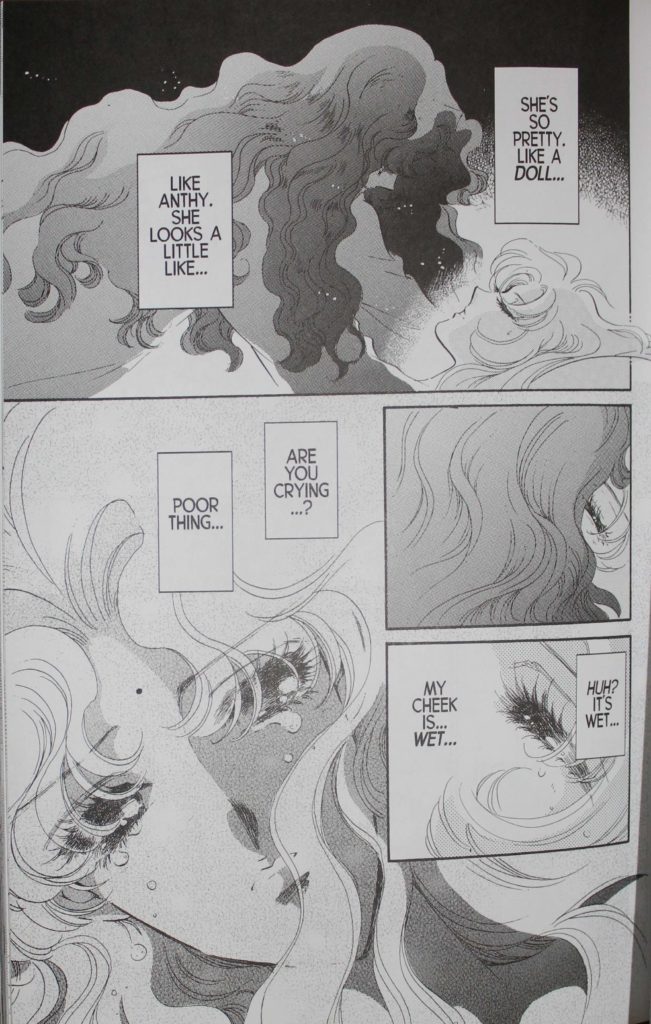
Through the skilled use of screen tones and ink techniques, Saito perfectly captures mood, and sets a tone for each scene.
Vol. 2, pg 61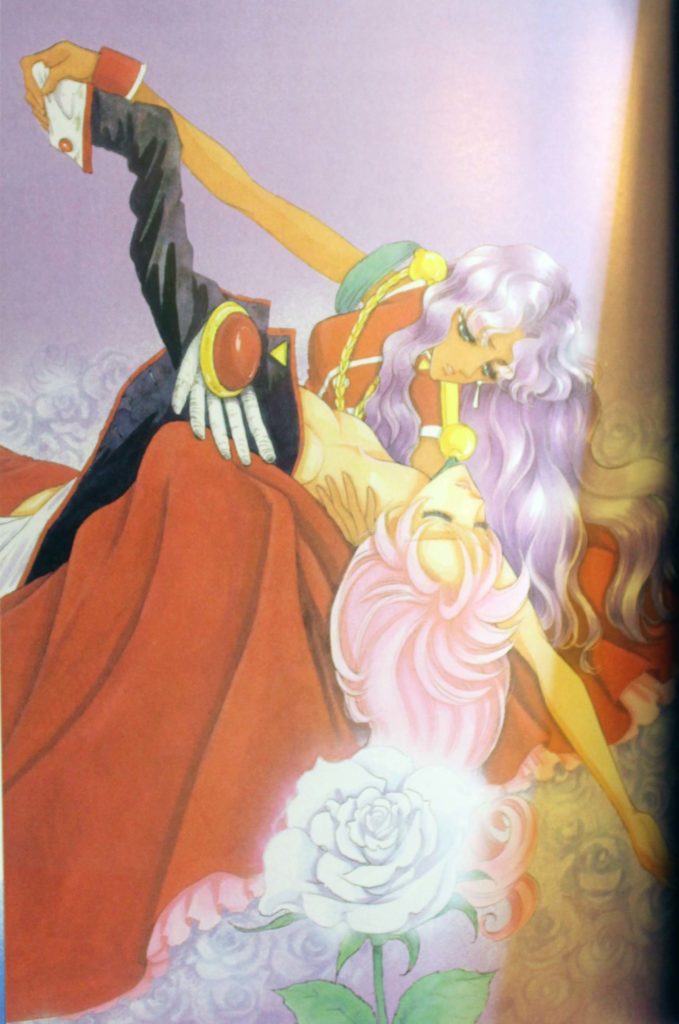
An example of some of the glossy color pages acting as openers for each volume.
Vol. 2, pg 1
Although sparse, there is a smattering of subtle humor throughout Revolutionary Girl Utena. The following are just a few scenes that garnered chuckles from me.
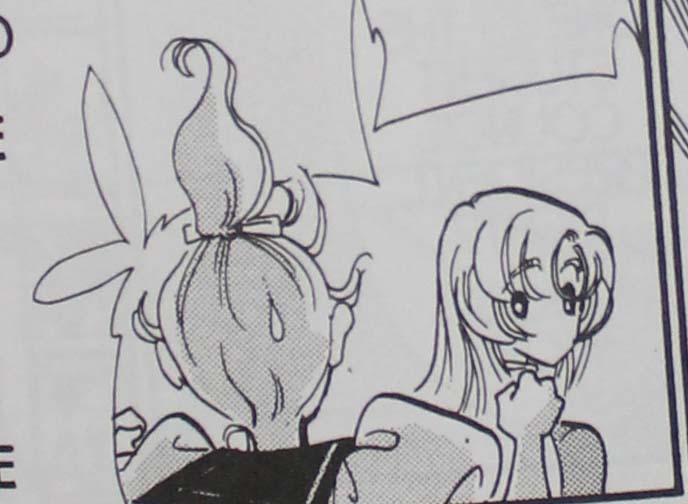
Underclassman Wakaba has an adorable crush on Utena, as well as ever expressive, moving hair. Her hair is as expressive as her face at times.
Vol. 1, pg 114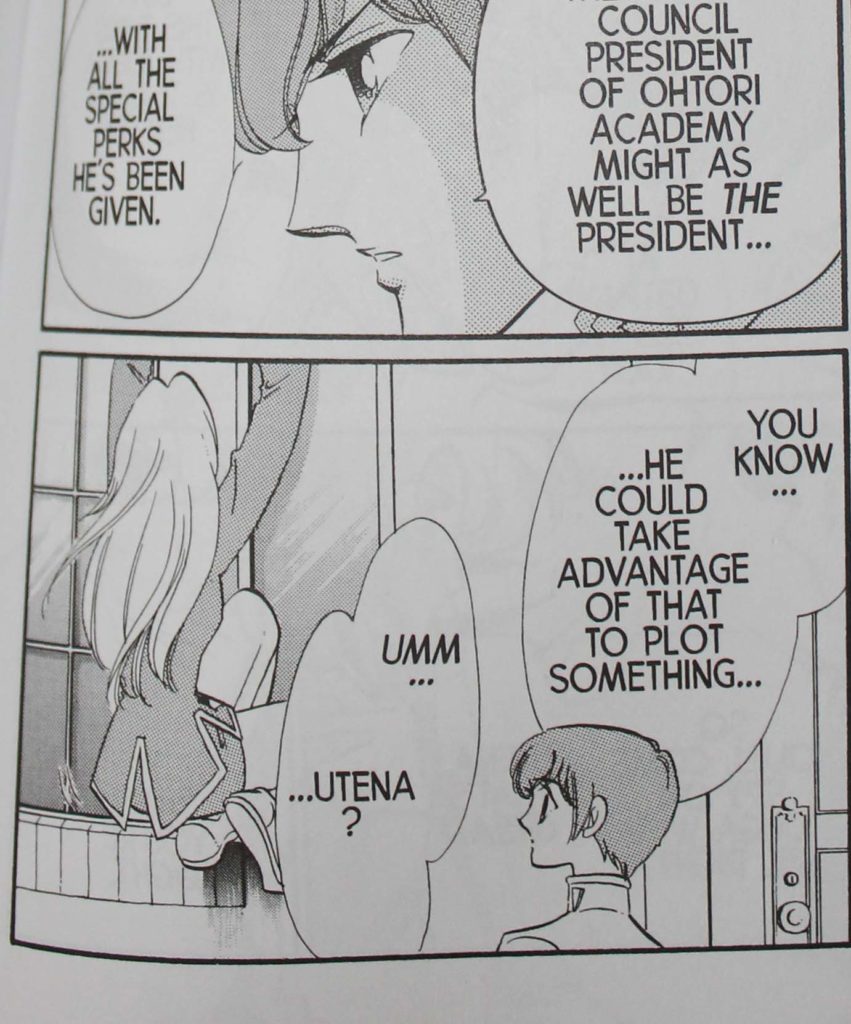
Utena’s instinct to climb first, check doors later.
Vol. 1, pg 282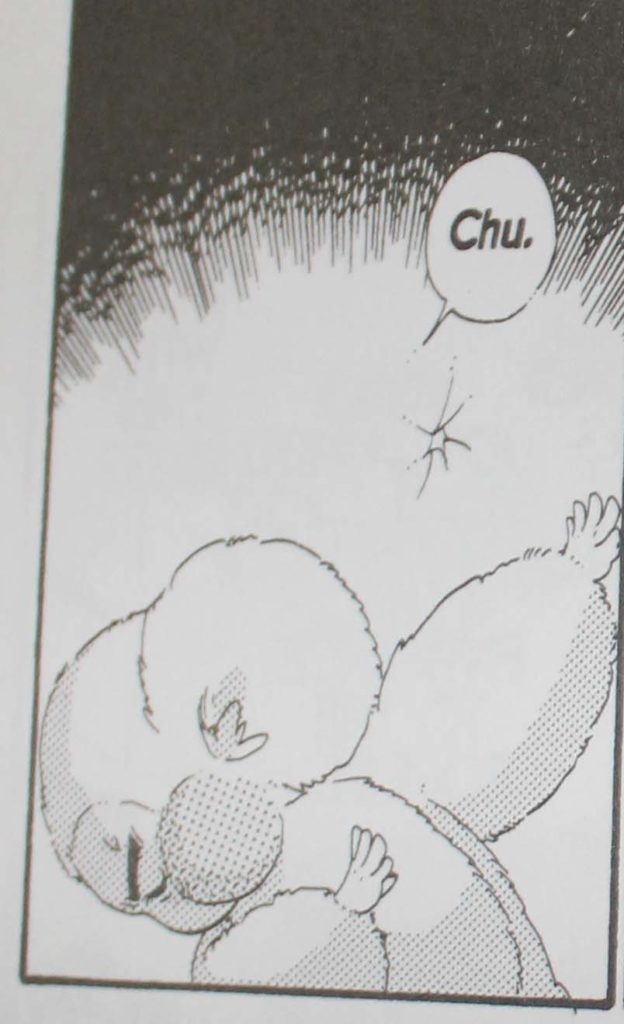
The original dab, circa 1997.
Vol. 1, pg 173
Okay, now is where I gush on the characters!
Utena. Utena, Utena! I may have a girl crush on her. She’s a stereotype-breaking rebel with a heart of gold and locks of soft pink. But while she sets a high moral standard, she’s also fallible in her gullibility and sometimes blind innocence.
She is imperfect, in spite of her overall nobility. This makes her relatable, especially to young teens. I watched Utena in my mid-20s, and I still got a bit starry eyed, despite my usual slight tinges of jading and cynicism.
She wants to do the right thing, and uses her moral compass in all situations. Unlike the other students, instead of shallowly judging by outside appearances, Utena takes the time to get to know people. While most of the girls are smitten with Saionji, she sees past his outer beauty and dislikes his abuse of Anthy. Likewise, while Anthy is a mystery, quiet, and hard to know, Utena takes her time try to understand and see another side of the shy girl. But even in her attempts to find the deeper truths behind each person, she is not impervious to failure, and those missteps in judgement have repercussions.
One of the most relatable aspects of Utena, at least to me, is her insecurity over, and questioning of, her identity. While on the exterior she is calm, cool, and collected, that very shell is the personification of her memory of another. In place of her missing “prince,” she has constructed her own identity to embody what she believes to be ideals he values: She is her own prince while she searches for the “real deal,” and in truth searches to validate her own identity. Does she need a prince? Or is it enough to be what she idolizes? Can both exist? Must they be mutually exclusive?
Furthermore, several times throughout the story, characters try to convince Utena that she should not be a prince, but rather take up the role of the protected and owned: to be a princess as society’s construct of gender implies she should be.
At times, she falls prey to this coercion. But in the end, she rises above her insecurities, becomes true to herself and her identity, and even sacrifices herself to protect the ones she loves.
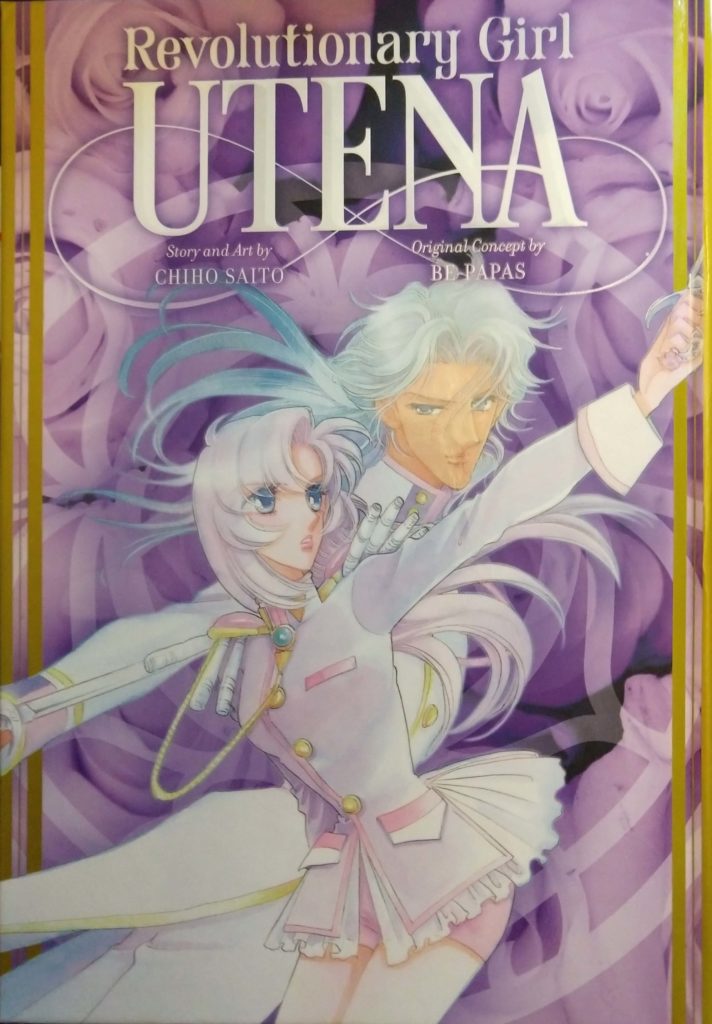
Volume 2, Cover.
I want to also give credit to some of the male supporting characters. Touga, while seemingly nothing more than a womanizing manipulator, actually becomes Utena’s most loyal ally. He is the one who time and again states that becoming a prince transcends gender: it makes no difference, if you’re a prince in your heart, then you’re a prince. It is in fact Utena’s strength and perseverance which draws Touga to her, and that which he loves about her. He doesn’t want a docile, submissive “princess,” he wants a strong, self-realized woman with integrity. And Utena proves time and again that she is just as noble as any prince preceding her.
More than that, Touga loves Utena for who she is, flaws and all. The feminine, the masculine. It’s an admiration that rivals Utena’s own respect for her prince.
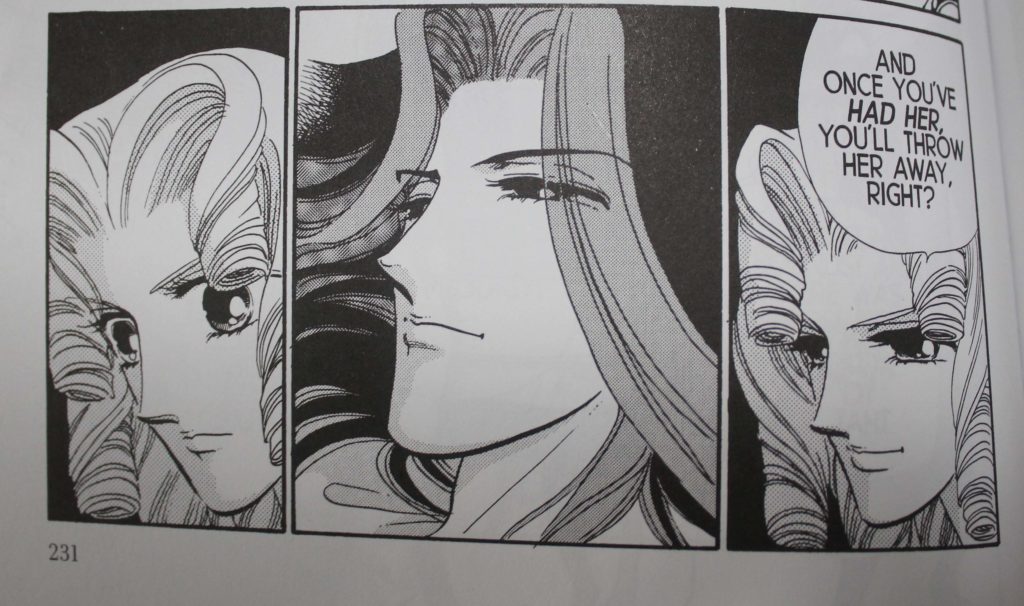
Vol. 1, pg 231
*The following paragraphs have some spoilers*
I also like how we see that Utena’s hero, Dios, was also imperfect. She spends her whole life deifying him, just as others before her did, but comes to realize that for all her adoration, the being that is Dios was flawed and in a way caused his own downfall. He is kind, he is giving, but in giving too much he encouraged people to look to him for all answers, rather than looking within themselves to grow and become strong. And he created the divide within himself, setting the stage for a vicious cycle. This dependency extended even to his lover, Anthy. Rather than fighting for herself, her love for him and his unexpected downfall, made Anthy incapable of defending herself.
In a way, Anthy and Utena are alike. They are yin (Anthy) and yang (Utena.) Both are in a position of longing for their prince. But while Anthy internalized the power of Dios, allowing it only to come out and be used by another to save her, Utena externalized that longing to become the savior. Both loved the same man, but their reactions to that love are expressed very differently. It’s also very complex how Utena, while wanting Dios, is also possessed of Dios. The two are one, but they are also independent of each other. It’s an idea that I think someone else could better explore, but I wanted to touch upon.
Cons (some spoilers)
I want to keep this part short. There aren’t too many, but I should mention them.
Sometimes, especially toward the end of Volume Two, the story gets a little confusing. I feel the end was a little rushed, and could have been better executed. Without spoiling too much, I’m talking about when Anthy’s, Akio’s and Dios’ identities are finally revealed.
Likewise, the side stories and their placement in the storyline can be confusing, and also contradict the end of main story. I’m not talking about the silly little fun side chapters like “To Curry Favor,” I’m mostly talking about “The Adolescence of Utena.” The Anthy at the end of “To Blossom” is not the same Anthy in “The Adolescence.” It left me confused. Is this yet another life? What’s going on? She sure did change from just one side story ago! When does this take place, and why is this cycle still happening? I thought the chain was broken?
Some of translations are a bit cheesy. Most of it’s okay, but I rolled my eyes so hard at the line “honeyed words” (87) (Saito 2, 2017). Seriously? Likewise, Touga’s supposed to be menacing in one scene, but the dude’s got a Wizard of Oz shirt on. I mean, I guess if it was the witch or creepy monkeys, but no. It just says “Wizard of Oz” (297) (Saito 1, 2017). Hard to be menacing with that shirt on, man.
Sometimes the hands are comically large, such as on the cover of Volume One. I’m sorry, the art’s beautiful, but those hands on both of them are distracting (see the image at the beginning of the review.)
The incest. I could handle it among “gods,” but not so much humans. I mean, maybe I’ve been conditioned by the Egyptian gods, I dunno? It just seems it would matter less with gods than with humans.
I think that about wraps it up. I have a few other minor nit picks, but nothing worth mentioning at the moment. Feel free to comment!
Parting Thoughts
Much like with Sailor Moon, I have so many thoughts I’d like to explore with Revolutionary Girl Utena. I feel I’ve merely touched the tip of the ice-berg, and yet, there’s so much more uncovered. And that’s after nearly writing a full blown essay. Still, I feel this is a good start, and I think it’s more than enough food for thought for those going into the story for the first, second, or even third time!
I found it interesting that the Be-Papas team was founded by Kunihiko Ikuhara, who was the producer for the anime Revolutionary Girl Utena, but also for Sailor Moon. Ikuhara must have had one heck of an eye for talent, because in spite of Saito’s very humble comments found in the deluxe manga that I read, her skill for storytelling and art shine through in these volumes.
I highly recommend these manga, but with a caveat. I think it’s fair of me to warn persons who have had traumatic histories, that “The Adolescence of Utena” chapter deals with some pretty heavy topics, including date rape; incest; slavery; and pedophilia. If something of that nature triggers a stress response in you, I would caution you against reading at least that portion of the story. While the main chapters of Utena do touch upon the concept of slavery and have a cursory show of domestic violence in Saionji’s abuse of Anthy, these are much less graphic in their depictions. Not that “The Adolescence of Utena” shows any sex scenes explicitly, but there’s enough there I was a little disturbed.
That said, I do still recommend this compilation. Just recognize that you’ve been forewarned.
Thanks for reading!
HIGHLY RECOMMENDED
Citations:
Gibaldi, Joseph. MLA Handbook for Writers of Research Papers. 6th ed. New York: The Modern Language Association of America, 2003.
Harman, William and Hugh Holman. A Handbook to Literature. 9th ed. Upper Saddle River: Prentice Hall, 2003.
Saito, Chiho and Be-Papas. Revolutionary Girl Utena. Trans. Lilian Olsen. Vol. 1. San Fransisco: Viz Media, 2017.
Saito, Chiho and Be-Papas. Revolutionary Girl Utena. Trans. Lilian Olsen. Vol. 2. San Fransisco: Viz Media, 2017.
0 Responses
Stay in touch with the conversation, subscribe to the RSS feed for comments on this post.